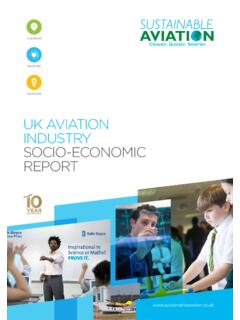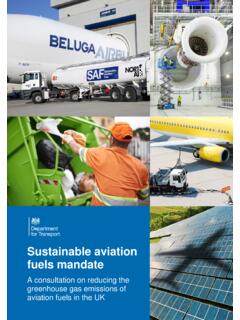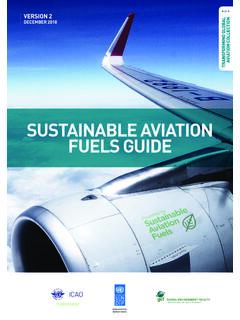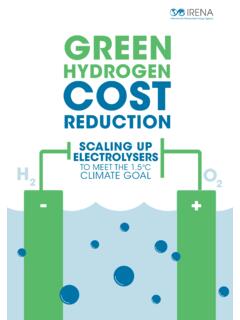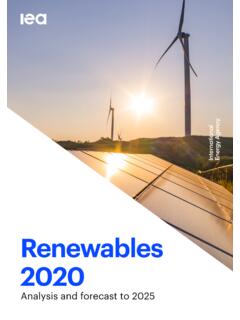Transcription of Sustainable Aviation Carbon Report
1 DECARBONISATION ROAD-MAP: A PATH TO NET ZEROA plan to decarbonise UK Aviation (SA) believes the data forecasts and analysis of this Report to be correct as at the date of publication. The opinions contained in this Report , except where specifically attributed to, are those of SA, and based upon the information that was available to us at the time of publication. We are always pleased to receive updated information and opinions about any of the statements in this Report (other than statements of historical facts) that address future market developments, government actions and events, may be deemed forward-looking statements . Although SA believes that the outcomes expressed in such forward-looking statements are based on reasonable assumptions, such statements are not guarantees of future performance: actual results or developments may differ materially, due to the emergence of new technologies and applications, changes to regulations, and unforeseen general economic, market or business Aviation is grateful to the following organisations for leading the work in producing this Road-Map:Decarbonisation Road-Map: A Path to Net Zero2 CONTENTS2020 is a critical year for global climate action.
2 Amidst growing consensus that the global community must act now to avoid the worst consequences of climate change, the UK will host world leaders at COP 26 in Glasgow. Aviation has to play its full part in delivering a zero Carbon future, and it is with considerable pride that alongside the publication of our new Decarbonisation Road-Map, UK Aviation as represented through Sustainable Aviation , has become the first national Aviation sector to commit collectively to achieving net zero Carbon emissions by commitment is a considerable step forward from the existing global industry target to half net emissions by 2050, and recognises the need for Aviation to go further, faster in reducing our Carbon footprint. We call on the international bodies to build on the achievements that have been made to date by establishing a new long-term target, which is led by climate science and consistent with the Paris Agreement.
3 Sustainable Aviation s new Road-Map, draws upon the latest science and innovative opportunities to decarbonise Aviation . It shows that it is possible for UK Aviation to achieve net zero Carbon meeting anticipated increasing demand for flying, with all of the benefits that brings to the UK s economy and society. Indeed, the UK can develop its role as a global leader in Sustainable Aviation technologies innovating and introducing new, low Carbon technologies, from new engine and aircraft designs to ground-breaking Sustainable Aviation fuels. A successful, Sustainable Aviation sector offers tremendous opportunities for the UK to create new highly skilled and highly paid the coming years Aviation will change, alternative fuels will power more long haul flights, aircraft will become more efficient and increasingly electrified, and precision satellite guidance will drive further efficiencies.
4 Aviation is determined to deliver these changes to meet the critical challenge of climate change, but we cannot do so alone. Alongside this new Road-Map and the industry s commitment is a call to work in close partnership with UK Government. This collaborative approach is essential to achieving the opportunities to decarbonise, and to ensure that the UK leads internationally - delivering a global framework to address Aviation emissions in what is, by definition, an international Robinson Chair, Sustainable AviationCHAIR FOREWORDC limate change is a clear and pressing issue for people, businesses and governments across the world. We know Aviation emissions will increase if decisive action is not taken, and that s why UK Aviation today commits to achieving net zero Carbon emissions by 2050, through an international approach, working with governments around the world and through the UN.
5 The UK is well positioned to become one of the leaders in the green technologies of the future, including Sustainable Aviation fuels and electric flight, creating highly-skilled and well-paid jobs in the process, and we look forward to working in partnership with Ministers to help realise these Aviation declarationThe climate policy landscape has changed dramatically since the previous CO2 Road-Map was published in 2016. The United Nation s Paris Agreement called on all countries to engage in climate action to maintain the global average temperature increase below 2 C and aim to limit it to below C compared to pre-industrial levels. In 2018, the Intergovernmental Panel on Climate Change (IPCC) Special Report concluded limiting global warming to C would require unprecedented and deep emissions reductions in all sectors and a decrease in global CO2 emissions by about 45% by 2030 compared to 2010, reaching net zero by 2050.
6 In addition to substantially reducing CO2 emissions, this will require balancing residual emissions by removing an equal amount from the atmosphere ( Carbon dioxide removal). At a national level, following this call to action and upon advice from the UK s Committee on Climate Change, in 2019 the UK Government legislated to bring all greenhouse gas emissions to net zero by 2050. The SA Advisory Board welcomes this Road-Map and the new commitment to net zero Carbon emissions for UK Aviation by 2050. We acknowledge the efforts that all parts of the industry have made to decarbonise both immediately and going forward. The Road-Map provides a helpful framework for the UK Aviation industry on a pathway towards net zero and identifies the policy and support measures the industry requires to get there. It is welcomed that the Road-Map responds to previous SA Advisory Board members calls for the industry to step up its commitment on decarbonising the the future, we encourage SA to build on this Road-Map with further detail that identifies the key policy interventions that would support the UK viation industry both to fulfil its net zero commitment and to grow the level of climate change ambition across the industry.
7 Lastly, CO2 should not be considered in isolation, as other Aviation emissions which also have a warming effect need to be accounted for. We recognise that the associated scientific uncertainty has delayed action in the past, but a clearer understanding is likely to emerge during the lifetime of this new Road-Map and we hope SA will respond appropriately. We look forward to a continued close working relationship with the UK Aviation industry during such a pivotal time for the sector and climate change policy. The SA Advisory BoardThe Sustainable Aviation Advisory Board works with Sustainable Aviation to provide independentadvice and feedback. It provides rigorous challenge to the SA Council in order to enable it to reach its cleaner, quieter, smarter goals effectively and BY Sustainable Aviation S ADVISORY BOARDP otential path to net zeroPotential path to global industry goal(50% of 2005 level) MtCO220222024202620282030203220342036203 8204020422044204620482050UK Aviation Carbon Emissions (MtCO2)Activity Growth (without Carbon price)Effect of Carbon Price on DemandImproved Operations / ATMF leet Upgrades, with known aircraft typesFleet Upgrades, with future aircraft typesSustainable FuelsGross Emissions (CO2 emissions from UK departing flights before offset and removal)Market Based Measures MBMs - specifically EU ETS + CORSIAMBMs ( Carbon removal measures)Net Emissions]usinglessfuelDecarbonisation Road-Map.
8 A Path to Net Zero5 EXECUTIVE SUMMARYS ustainable Aviation Decarbonisation Road-Map: A Path to Net Zero EmissionsClimate change is a clear and pressing issue for people, businesses and governments across the world. In publishing this Report , UK Aviation is committing to achieving net zero emissions by 2050, through an international approach, working with governments around the world and through the 2050, the UK Aviation industry can achieve net zero Carbon emissions through the following initiatives compared with a scenario of growth at today s efficiency: Million tonnes of Carbon dioxide (MtCO2) saving due to Carbon pricing impact on demand MtCO2 saving from better air traffic management and operating procedures saving from introduction of known and new, more efficient aircraft saving from Sustainable Aviation fuels MtCO2 saving from effective market-based measuresOur Road-Map draws on expertise from all corners of the UK Aviation industry, including airlines, airports, aerospace manufacturers and air navigation service providers.
9 It is based on a thorough review of the opportunities to cut Aviation Carbon emissions through smarter flight operations, new aircraft and engine technology, modernising our airspace, the use of Sustainable Aviation fuels and significant investment in Carbon reductions through effective market-based policy these actions, the UK will be able to accommodate 70% growth in passengers through to 2050 whilst reducing net emission levels from just over 30 million tonnes of CO2 per year down to Road-Map for UK Aviation2016010203040506070802050 Do nothing2050 Emission ReductionOptions2050 Emission once reductions are implementedUK Aviation Carbon Emissions (MtCO2)Effect of Carbon price on demandAirspace and operational improvementsFleet upgrades with new aircraft technologySustainable Aviation FuelsMBMs (including EU ETS, CORSIA and Carbon removal measures)UK Aviation CO2 emissionsOpportunities to deliver net zero emissions for UK aviationDecarbonisation Road-Map: A Path to Net Zero6 EXECUTIVE SUMMARYS ustainable Aviation Decarbonisation Road-Map.
10 A Path to Net Zero Emissions (continued)To deliver this will require a partnership approach with Government to ensure the opportunities to cut emissions are realised through smart low Carbon policies, collaborative actions from outside the Aviation sector and substantial investment from industry and Government in the next generation of Sustainable Aviation a part of a global industry, with global emissions, the UK Government and industry must also take an international approach to ensure UK actions on emissions do not create unintended Carbon emissions elsewhere outside the UK or undermine the UK s international ask the UK Government to support this commitment in the following ways:Improvements in Aircraft and Engine EfficiencyWith the right support from Government our world-class Aviation and aerospace sectors are uniquely placed to capitalise on the opportunities of green Aviation technology such as new propulsion systems, including hybrid and electric technology, and lighter, more efficient aircraft.

